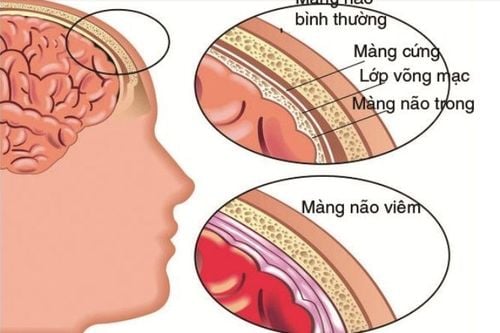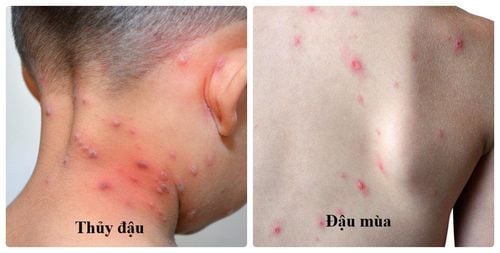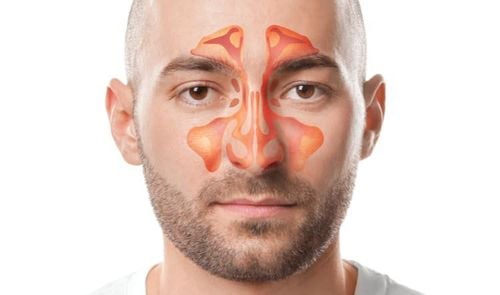Sinusitis is a common ENT disease, causing pain and discomfort and affecting patients' daily activities. Furthermore, sinusitis causes eye complications and headaches.
1. Sinusitis
Sinusitis is an inflammation of the hollow cavities inside the craniofacial mass, which occurs when the hollow cavities are blocked and contain a lot of pus, leading to inflammation of the mucosa. Causes symptoms including sneezing, runny nose, pain in the face, ... like a cold.
Sinusitis is divided into 4 types including:
- Acute sinusitis: These symptoms appear suddenly and do not go away after 10-14 days.
- Subacute sinusitis: Lasts about 4-8 weeks.
- Chronic sinusitis : Disease duration lasts more than 8 weeks.
- Recurrent sinusitis: Recurrence episodes in 1 year
2. Cause

Sinusitis is caused by allergens entering the sinuses. Allergic sinusitis depends on antigens, especially antigens that are strong and foreign to the body. Allergic agents from the daily living environment and encountering an allergic body will cause the disease to appear earlier and more severe, for example: dog hair, cat hair, pollen, bugs, mites, dust dirty,...
Some cases of sinusitis due to excessive use of decongestant sprays or smoking, drugs also increase the risk of sinusitis. Allergic sinusitis is rarely associated with fever unless there is a microbial superinfection.
People at high risk for sinusitis are those who have nasal polyps or a deviated septum that will interfere with sinus drainage.
Sinusitis can be caused by an infection with microorganisms including: Bacteria, viruses or parasites it is called infectious sinusitis. Infectious sinusitis is often accompanied by mild fever, but sometimes accompanied by high fever, chills, headache,... Also accompanied by inflammation of some other respiratory tract including: Inflammation tonsils, nose, and throat, and can cause ear infections.
There are many other causes of sinusitis such as: Changes in temperature or air pressure in cases when flying or diving in the sea. Sinusitis can be acute or chronic. If in the case of chronic sinusitis, the treatment will be more difficult and there is also a greater risk of causing dangerous complications.
3. Complications
Acute sinusitis is inflammation of the cavity when symptoms appear for a short time, less than 4 weeks. Symptomatic chronic sinusitis persists for more than 12 weeks. When a patient has acute sinusitis, if not treated promptly, there is a high risk of chronic sinusitis and complications. When complications occur, the disease is often very severe and can be life-threatening.
3.1 Eye complications
The most common complication due to sinusitis is orbital infection accounting for a very high rate of about 85%, of which about 10% will be blind. The cause of eye complications is inflammation of the ethmoid sinus, a rare case of inflammation of the maxillary and frontal sinuses. The inflammatory process follows the blood vessels from the sinuses through the orbit or spreads, causing complications in the eyes.
In addition, it can lead to inflammation of the connective tissue around the eyes. This complication is common in cases of acute sinusitis. The patient has severe eye pain, often pain on the top of the head. Swollen eyelids due to accumulation of pus in the eye socket. Due to inflammation of the ethmoid sinus or sphenoid sinus can lead to complications of optic neuritis.
In addition, sinusitis can also cause inflammation of the lacrimal sac, eyelid abscess.
3.2 Complications of headaches
Sinusitis headaches are related to swelling of the lining of the sinuses. Pain occurring in the affected area is the result of pus, air, and mucus getting trapped in the cavity. The discomfort often occurs in the upper and lower teeth, creating a headache-like sensation, which increases when the patient bends the head forward or when lying down.
Sinusitis even leads to dangerous complications including:
- Meningitis
- Epidural abscess
- Subdural pus collection
- Upper longitudinal venous sinusitis
- Obstruction of cavernous sinus vein
- Brain abscess
Meningitis is a rare but extremely dangerous condition that can lead to death. Common signs are severe toxic infection syndrome manifested by increased intracranial pressure, clinical manifestations include nausea, headache, high fever, photophobia, mental stagnation, stiff neck. However, sometimes the symptoms are atypical and very obscure if the lesion is only in the frontal lobe...

4. Treatment and prevention of complications
Treatment of sinusitis should first make the sinuses drain well, and then control or eliminate the source of the inflammation to relieve pain.
- Breathing in moist air can help relieve pain by humidifying the air with a nebulizer or humidifier.
- Patients need frequent nasal irrigation to clear mucus that causes congestion, flushing out allergens, irritants, and bacteria.
- Use medications prescribed by your doctor to reduce inflammation and reduce congestion.
- When there are abnormal signs, suspected of having sinusitis, it is necessary to see a doctor as soon as possible, should be examined at an ear, nose, and throat specialist.
Vinmec International General Hospital is one of the hospitals that not only ensures professional quality with a team of leading medical doctors, modern equipment and technology, but also stands out for its examination and consultation services. comprehensive and professional medical consultation and treatment; civilized, polite, safe and sterile medical examination and treatment space.
Please dial HOTLINE for more information or register for an appointment HERE. Download MyVinmec app to make appointments faster and to manage your bookings easily.













